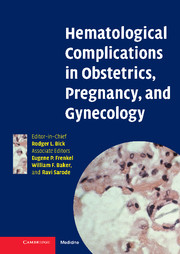Book contents
- Frontmatter
- Contents
- List of contributors
- Preface
- 1 Disseminated intravascular coagulation in obstetrics, pregnancy, and gynecology: Criteria for diagnosis and management
- 2 Recurrent miscarriage syndrome and infertility caused by blood coagulation protein/platelet defects
- 3 Von Willebrand disease and other bleeding disorders in obstetrics
- 4 Hemolytic disease of the fetus and newborn caused by ABO, Rhesus, and other blood group alloantibodies
- 5 Hereditary and acquired thrombophilia in pregnancy
- 6 Thromboprophylaxis and treatment of thrombosis in pregnancy
- 7 Diagnosis of deep vein thrombosis and pulmonary embolism in pregnancy
- 8 Hemorrhagic and thrombotic lesions of the placenta
- 9 Iron deficiency, folate, and vitamin B12 deficiency in pregnancy, obstetrics, and gynecology
- 10 Thrombosis prophylaxis and risk factors for thrombosis in gynecologic oncology
- 11 Low molecular weight heparins in pregnancy
- 12 Post partum hemorrhage: Prevention, diagnosis, and management
- 13 Hemoglobinopathies in pregnancy
- 14 Genetic counseling and prenatal diagnosis
- 15 Thrombocytopenia in pregnancy
- 16 Neonatal immune thrombocytopenias
- 17 The rational use of blood and its components in obstetrical and gynecological bleeding complications
- 18 Heparin-induced thrombocytopenia in pregnancy
- 19 Coagulation defects as a cause for menstrual disorders
- Index
- Plate section
- References
18 - Heparin-induced thrombocytopenia in pregnancy
Published online by Cambridge University Press: 01 February 2010
- Frontmatter
- Contents
- List of contributors
- Preface
- 1 Disseminated intravascular coagulation in obstetrics, pregnancy, and gynecology: Criteria for diagnosis and management
- 2 Recurrent miscarriage syndrome and infertility caused by blood coagulation protein/platelet defects
- 3 Von Willebrand disease and other bleeding disorders in obstetrics
- 4 Hemolytic disease of the fetus and newborn caused by ABO, Rhesus, and other blood group alloantibodies
- 5 Hereditary and acquired thrombophilia in pregnancy
- 6 Thromboprophylaxis and treatment of thrombosis in pregnancy
- 7 Diagnosis of deep vein thrombosis and pulmonary embolism in pregnancy
- 8 Hemorrhagic and thrombotic lesions of the placenta
- 9 Iron deficiency, folate, and vitamin B12 deficiency in pregnancy, obstetrics, and gynecology
- 10 Thrombosis prophylaxis and risk factors for thrombosis in gynecologic oncology
- 11 Low molecular weight heparins in pregnancy
- 12 Post partum hemorrhage: Prevention, diagnosis, and management
- 13 Hemoglobinopathies in pregnancy
- 14 Genetic counseling and prenatal diagnosis
- 15 Thrombocytopenia in pregnancy
- 16 Neonatal immune thrombocytopenias
- 17 The rational use of blood and its components in obstetrical and gynecological bleeding complications
- 18 Heparin-induced thrombocytopenia in pregnancy
- 19 Coagulation defects as a cause for menstrual disorders
- Index
- Plate section
- References
Summary
Heparin is the most commonly used pharmacologic intervention to prevent or treat thrombosis in pregnancy. Both unfractionated heparin and low molecular weight heparins have been used successfully for therapeutic and prophylactic anticoagulation during gestation. Conversely, the use of coumadin in pregnancy is not advised as the drug crosses transplacentally and has been associated with a risk of fetal embryopathy and hemorrhage. The use of heparin, however, can have adverse clinical side effects for the pregnant female that include heparin-associated osteoporosis, eosinophilia, allergic reactions, ski rashes, and alopecia. However, the most significant and potentially devastating consequence is the development of heparin-induced thrombocytopenia. This is particularly true when the thrombocytopenia is paradoxically associated with either a venous or arterial thrombosis. Although heparin and low-molecular-weight (LMW) heparins are generally considered safe during pregnancy, a recent adverse reaction MedWatch report has been issued regarding the use of enoxaparin in pregnancy. This MedWatch report, issued January 9 2002 states the following: PRECAUTIONS:
Pregnancy
Teratogenic effects
There have been reports of congenital anomalies in infants born to women who received enoxaparin during pregnancy including cerebral anomalies, limb anomalies, hypospadias, peripheral vascular malformation, fibrotic dysplasia, and cardiac defect. A cause and effect relationship has not been established nor has the incidence been shown to be higher than in the general population.
Non-teratogenic effects
There have been post-marketing reports of fetal death when pregnant women received Lovenox Injection. Causality for these cases has not been determined. Pregnant women receiving anti-coagulants, including enoxaparin, are at increased risk for bleeding. Hemorrhage can occur at any site and may lead to death of mother and/or fetus. […]
- Type
- Chapter
- Information
- Publisher: Cambridge University PressPrint publication year: 2006



